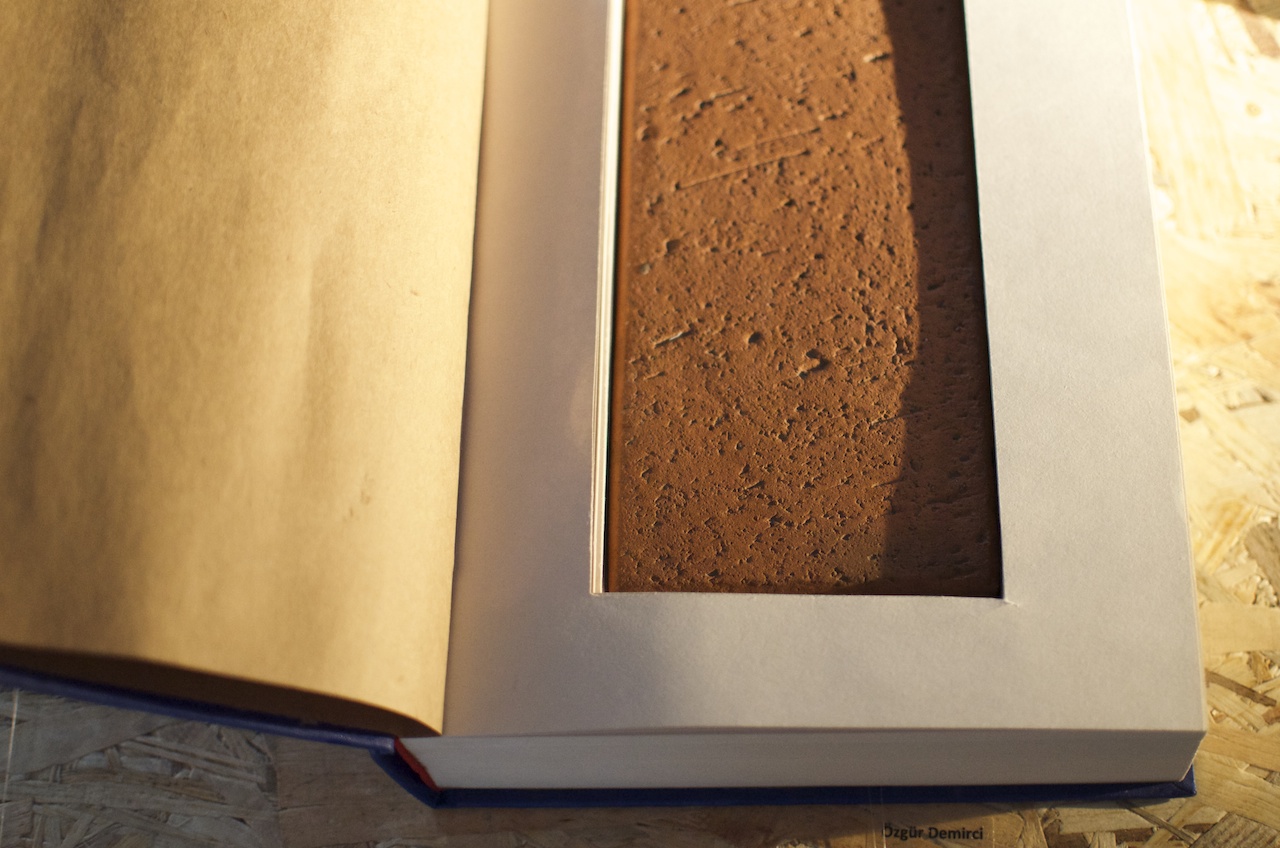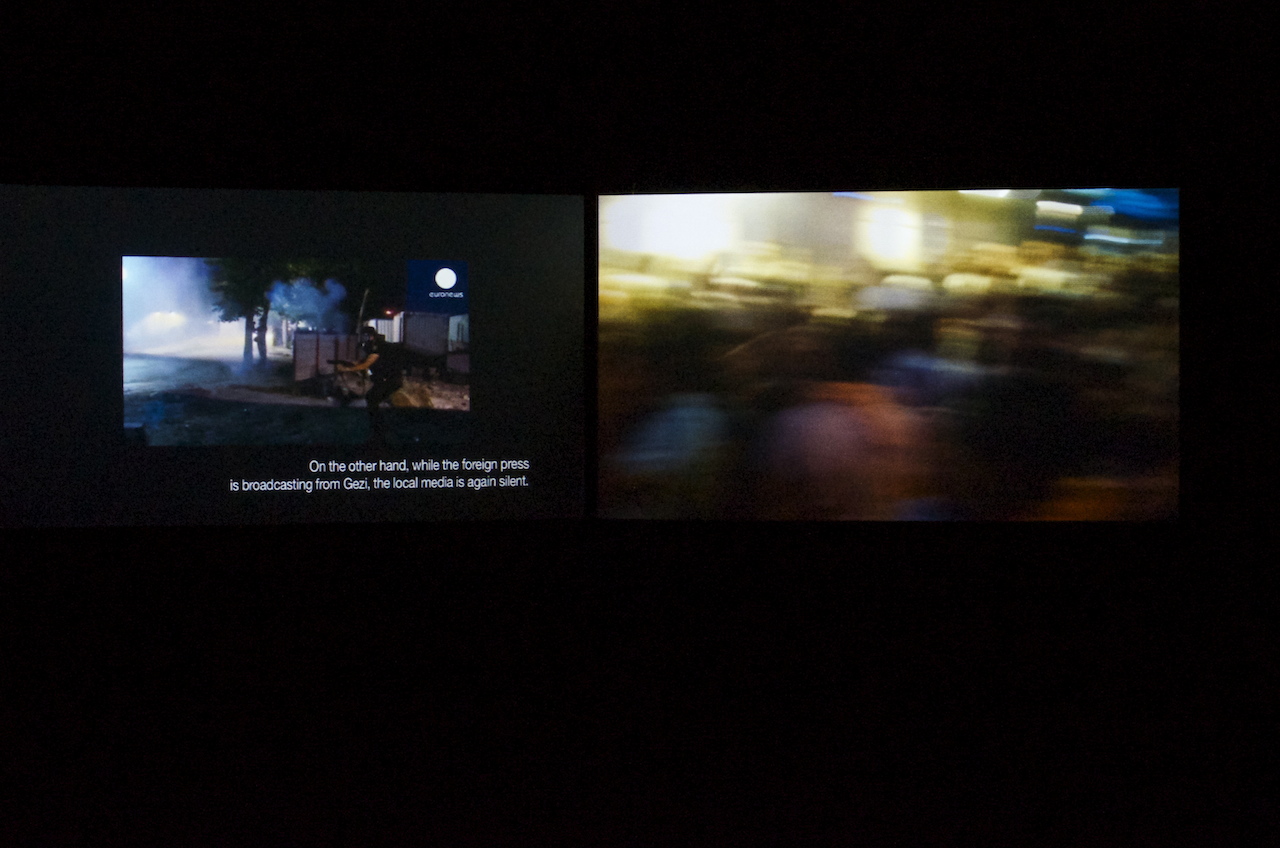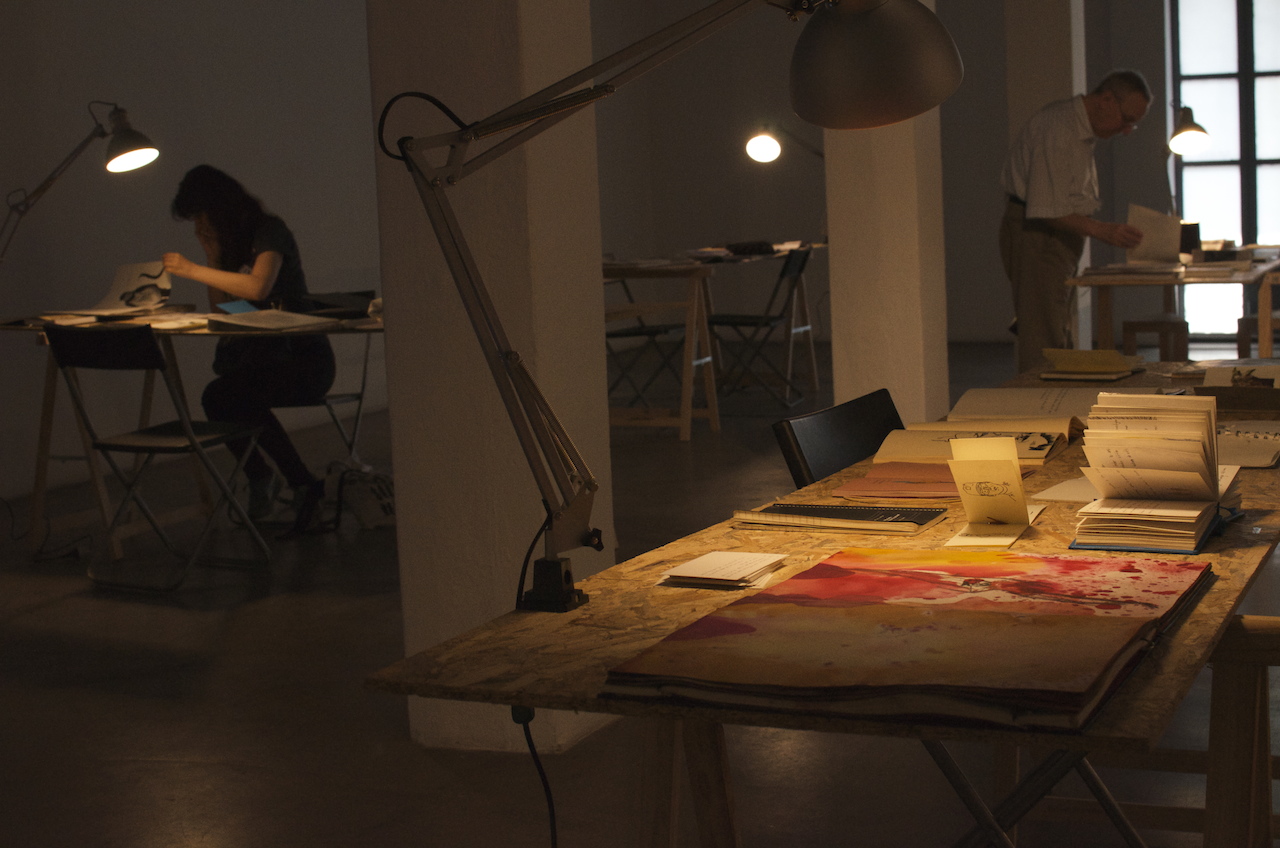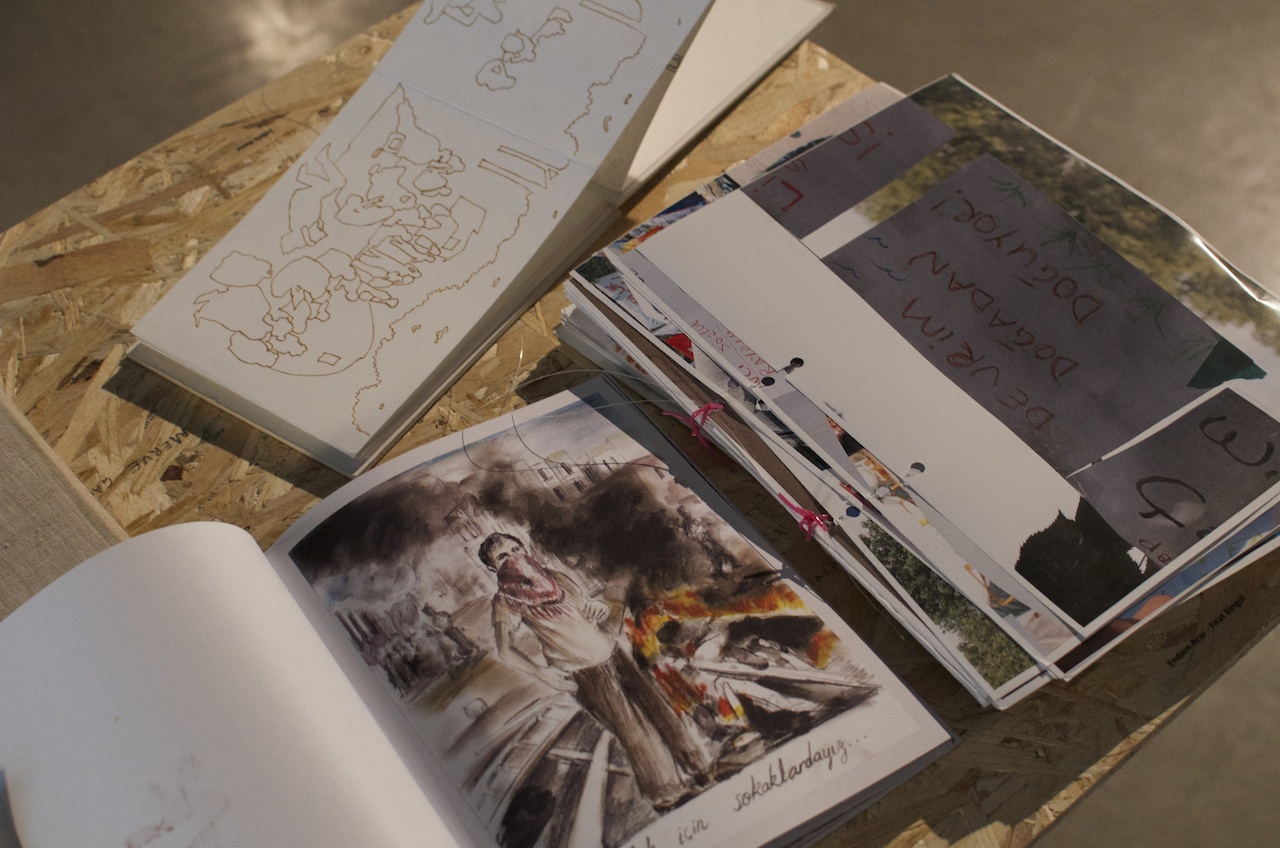In Two Istanbul Galleries, Artists Piece Together Memories of Gezi

Özgür Demirci, “Ammunition Book” (2014) laser cut notebook, paving stone (all photos by the author for Hyperallergic unless otherwise noted)
ISTANBUL — Central Istanbul looks markedly different today than it did around this time two years ago. As the water-bound metropolis slides smoothly into summer, there’s a Shake Shack on Istiklal Avenue (the city’s historic pedestrian artery) and thick concrete scar tissue grafted onto the side of Gezi Park. The TOMAs (Turkish-designed armored riot control vehicles, equipped with water cannons) have disappeared from Taksim Square, and evening strolls down Istiklal are no longer marred by the acrid bite of tear gas. Flags of political parties flutter above most streets, in preparation for
June’s general election — an election that the ruling AKP (Justice and Development Party) is expected to win.
The
Gezi Park protests that broke out on May 28, 2013, were a direct challenge to the AKP and to then-prime minister, now-president, Recep Tayyip Erdogan. Ostensibly an environmentalist, anti-capitalist movement that grew to incorporate a plurality of agendas and social groups, the demonstrations engulfed the country, and continued, in constantly evolving form, throughout the summer. Yet despite the transformational promise of this radical, social reorganization of Turkey’s urban spaces, the protests barely achieved their ostensible purpose — plans to demolish Gezi and replace the park with
an Ottoman-style shopping centre still linger — and hardly any physical trace of the movement remains.
The colorful, often drily humorous graffiti that erupted across Istanbul’s walls, castigating Erdogan and championing resistance, may have long since been washed away, but the intangible effects of Gezi are harder to erase than the movement’s public traces. Those involved have not forgotten the thrill of collective action; two years on, they are
taking stock.
“How am I to edit these in a meaningful sequence?” artist and filmmaker Didem Pekün asks in a voiceover at the crux of her video “Of Dice and Men,” as footage and photos of the Gezi summer flutter across the screen — a disjointed, kaleidoscopic stream of protests, pitched tents, heated clashes, and quiet joy. “Of Dice and Men,” a 29-minute video diary begun in 2011 and as yet unfinished, is currently on display at
SALT Beyoğlu on Istiklal.
A Century of Centuries, the group exhibition it is a part of, is concerned with exploring “the lasting effects of key periods and events within the longer trajectory of time they inhabit” — and Pekün’s work contextualizes the Gezi movement within a broader narrative of her life.
Pekün lives and works in both London and Istanbul, and “Of Dice and Men,” playing out on a double screen, seemingly nods to that duality. The footage is at times continuous across both screens, at other times split; the artist’s voiceover likewise swims between Turkish and English, bearing no particular correlation to where the accompanying scenes are set. Quotidian scenarios filmed across four years are studded with a recurring black-and-white die toss motif — an archetypal gesture that, here shown in slow motion, gestures to the knife-edge wobble that determines whether the “everyday ruptures” of Pekün videos will evolve into moments of historical importance, or subside merely into significant episodes in her personal history.

Didem Pekün, still from “Of Dice and Men” (2011–ongoing) (image courtesy SALT)
The video opens with handheld footage of London’s 2011 Occupy protests, before segueing into demonstrations over the unresolved assassination of Hrant Dink, an Armenian journalist, in Istanbul. Pekün is eager to examine the way violence functions in each society she’s a part of, and yet her dual life also leaves her with a sense of distance. “The most incredible things always happen when you’re away,” her voice intones, as she reveals that she was in her London office when bulldozers entered Taksim, and the Gezi movement began in earnest.
“[S]ome things are simply unrepresentable…” Pekün says before beginning her Gezi diary entry — yet her sutured footage manages to convey a period during which “No one knew what would happen so we didn’t want to sleep.” A split screen juxtaposing international media reports with handheld videos made from within the protests provides scenes of chaos and confusion, before snapping to a slideshow of images from the Gezi encampment and the nightly clashes: tired, smiling children, protesters sleeping side by side, a Guy Fawkes mask, a makeshift library, milling crowds, food being doled out. Each image shifts before the viewer is able to properly register it, like a flipbook of a running man — a dynamic, indelible portrait.
“How can we go back to regular life once we saw the sublime?” asks Pekün, after the protests are dispersed. “If we had one way of living before Gezi, how were we to find a new way after this?” The diary entry on the protests is structurally incorporated into the undulating, cyclical flow of the visual diary — a river of images that jumps from political crisis (
the Reyhanli bombing) to ordinary wonders (children chasing bubbles in a park; teenage boys leaping into the Bosphorus) — and yet Pekün’s memories make the event subjectively distinct: a point of rupture that cannot, within the fabric of the diaristic artwork, actually sever the narrative.

Didem Pekün, still from “Of Dice and Men” (2011–ongoing) (image courtesy SALT)
Pekün’s work is particularly powerful on the way history quickly accumulates without one’s involvement or attendance. Constantly shuttling between cities, she’s always running to catch up. Her images and words are inflected with a sense of transformation that is impossible to totally comprehend or even to witness: “My neighborhood had transformed completely,” she reflects, upon arriving in Istanbul after the protests had begun. Transience imbues the narrative, with recurrent images of movement, dispersion, flight. Rain streaks down a taxi window, birds swoop in circles, ducks ripple through water, eagles plummet to earth. After a helicopter crash, Pekün recalls, “I came out of the house, and saw its traces.”
Traces of Gezi surface in
Stay With Me, an exhibition currently on at Depo — a “space for critical debate and cultural exchange,” which, from SALT, is a short walk down an alley snaking off Istiklal (one of a number that once supplied handy escape routes for fleeing protesters and is now the domain of sun-drugged cats and sweaty tourists). The show pulls together Gezi detritus: notes, drawings, article clips, mementos — some scribbled and collected during that heady summer, others assembled later — compiled into notebooks by 84 of the movement’s participants.

Installation view of ‘Stay With Me’ at Depo, Istanbul
The show’s mission, as its title indicates, is one of retrieval. “Is it possible to remember this hope?” the exhibition materials ask. “We have to start somewhere…” And so they start with basic physical remains, enshrined in notebooks that are laid reverently across desks in the manner of a reading room or archive. Yet the overtly tactile quality of these objects suggests archaeology too: a physical search to uncover, catalogue, and remember a different era.
As in Pekün’s video, Stay With Me makes no attempt to form a coherent narrative of the protests. The exhibition spills over with scenes, perspectives, information, subjectivities, subtleties, all tucked into the pages of myriad notebooks, suffused with the endearing earnestness and irreverent humor that became Gezi’s hallmark. Some notebooks are immediately recognizable as products of the movement — newspaper clippings, protest flyers, chant lyrics, maps of marches, watercolors of water cannon assaults, ink portraits of protesters in gas masks — while others are more lateral: leaf rubbings, tree sketches, abstract oil paintings. There is a page pulled from Kafka, and a heavy tome entitled “Ammunition Book,” which opens to reveal a single, hefty brick.
Reminiscing about Gezi is one of the preferred pastimes of many Istanbullus that I’ve met — a wistful gaze generally accompanies these elegiac tributes, as if the dreamer were recalling a long-lost lover still thought of fondly. And yet both Depo’s show and Pekün’s video avoid self-indulgent nostalgia by virtue of their inherent immediacy. They pointedly do not showcase, to quote Wordsworth, “emotion recollected in tranquillity.” Rather, they are direct transcriptions of events: visual and physical imprints of a movement, preserved by its participants. As such, the two shows potently capture the spirit of Gezi, bringing its engaging optimism sharply into focus.
Yet one senses that memorializing the movement is not the highest aim of these shows. They champion resistance art and seem intended, ideally, to re-inflame the spirit of dissent in a country that has apparently moved on from it. Retrieval, as well as recollection, is yearned for. But to what extent can such projects succeed?

Gonca Seze, Endem Acar-Firat Bingol, and Lebriz Rona for ‘Stay With Me’
Pekün’s video incorporates Gezi into the workaday rhythms of life: the protests were both an immense break, and a way of being — for a brief time. Stay With Me presents the movement’s activism as a topic for academic study: a puzzle to reassemble, a pattern to follow. Both documentary efforts take as their premise the difficulty of remembering, the impossibility of holding onto this singular moment, and of packaging it neatly into a tidy narrative. The artists pursue memory — reaching for return, for permanence — while acknowledging the slipperiness of their prey. From this struggle, what emerges, improbably, is hope.
“Of Dice And Men” is on display in A Century Of Centuries, which continues at SALT Beyoğlu (Asmalı Mescit Mh., İstiklal Cd No:136, Beyoğlu, Istanbul) through May 24.
Stay With Me continues at Depo (Koltukçular Çk No:12, Beyoğlu, Istanbul) through June 7.
http://hyperallergic.com/208930/in-two-istanbul-galleries-artists-piece-together-memories-of-gezi/











